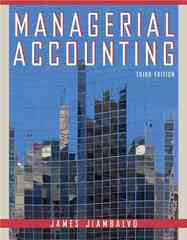
gagestion 4 Shepard Conlpany sold 2,000 units of its product at $108 per unit in 2008 and incurred operating expenses of $14 per unit in selling the units. It began the year with 840 units in inventory and made successive purchases of its product as follows: January 2 Beginning Inventory .............. 840 units @ $58 per unit April 2 Purchase ................................ 600 units @ $59 per unit June 14 Purchase ................................ 500 units @ $61 per unit August 29 Purchase ................................ 700 units @ $64 per unit November 18 Purchase ................................ 900 units @ $65 per unit Total 3,540 units Shepard Company uses a periodic inventory system. i) Determine the ending inventory and cost of goods sold amounts for the December nancial statement under the FIFO, LIFO and average-cost methods. ii) Prepare comparative income statements for the three inventory costing methods. iii) How would the nancial results from using the three alternative inventory costing methods change if Shepard had been experiencing decreasing prices in its purchases of inventory? Question 5 The ordering of material KL has caused concern in the past according to the chief accountant. There have been occasions when an excessive amount of stock has been carried beyond any possible demand and when the problem was addressed and the stock level cut, orders have been unfullled and sales lost because the company has run out of material KL. The chief accountant has said he wants a policy that achieves the following aims. o Adequate stock of material KL so as to minimize the risk of shortage and production dislocation. o This should be balanced with the avoidance of excessive stock levels of material KL and the consequent tying up of scarce resources. You are given the following information: i) Budgeted average demand for material KL is 400 kilos per week and production is maintained for 50 weeks in the year. ii) The ordering cost is $150 per order iii) The standard material cost of KL is $6 per kilo and carrying costs are 33 123% of that gure per annum, for each kilo iv) The maximum usage in any one-week is 600 kilos and the minimum 400 kilos. On average, the order takes anything from one to three weeks to be delivered after they have been placed. Required: In order to meet the chief accountant's objectives, determine the following a) The optimum order quantity that should be placed 1)) The reorder level for stock KL c) The minimum level of stock that should be held d) The maximum level of stock that should be held








